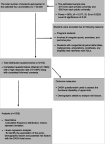Prevalence of upper limb pain and disability and its correlates with demographic and personal factors
- PMID: 31564961
- PMCID: PMC6735537
- DOI: 10.2147/JPR.S198480
Prevalence of upper limb pain and disability and its correlates with demographic and personal factors
Abstract
Purpose: The present study aimed to assess the prevalence of upper limb pain and disability and to investigate potentially correlated factors among university students in Jordan.
Methods: This was a cross-sectional questionnaire-based survey study that was conducted among university students. The upper limb pain and disability were assessed by the Disabilities of the Arm, Shoulder, and Hand (DASH) outcome questionnaire. The DASH outcome questionnaire was distributed to 2100 students from the population of 2 public and 2 private universities in the north of Jordan. Demographic and personal information were collected. Data were analyzed using descriptive statistics and linear regression analysis.
Results: A total of 1929 DASH outcome questionnaires were returned, with a high response rate of 91.86%. The age of the subjects was between 18-28 years (52% male; 48% female). The majority of subjects (85.2%) used at least one smartphone. The majority of them had been using a smartphone for more than 5 years. The prevalence of upper limb pain and disability among university students was 24%. Several factors were found to be significantly connected with upper limb pain and disability among university students, such as smartphone use, computer use, the presence of musculoskeletal problems, not living with their families, using public transport (bus), and daily housekeeping.
Conclusion: The results of this study can be used globally to promote the health and well-being of university students, improve their academic performance and future career. Identifying high-risk groups will assist in early identifications and prevention programs for upper limb pain and disability among university students.
Keywords: DASH questionnaire; electronics’ users; prevalence; socio-demographic; university students; upper limb disability.
© 2019 Almomani et al.
Conflict of interest statement
The authors report no conflicts of interest in this work.
Figures
References
-
- Walker-Bone K, Palmer KT, Reading I, Coggon D, Cooper C. Prevalence and impact of musculoskeletal disorders of the upper limb in the general population. Arthritis Rheum. 2004;51(4):642–651. - PubMed
-
- Palmer KT, Calnan M, Wainwright D, et al. Upper limb pain in primary care: health beliefs, somatic distress, consulting and patient satisfaction. Fam Pract. 2006;23(6):609–617. - PubMed
-
- Borghouts JA, Koes BW, Bouter LM. The clinical course and prognostic factors of non-specific neck pain: a systematic review. Pain. 1998;77(1):1–13. - PubMed
LinkOut - more resources
Full Text Sources


